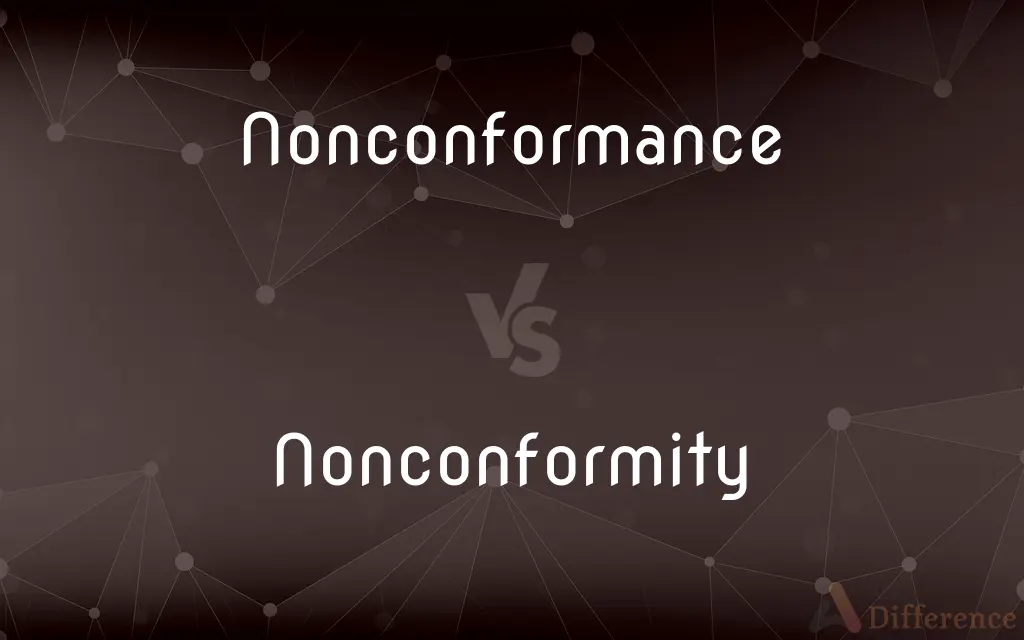Nonconformance vs. Nonconformity — What's the Difference?
By Urooj Arif & Maham Liaqat — Updated on April 19, 2024
Nonconformance typically refers to deviations in products or processes from specified standards, while nonconformity often describes behavior or actions not aligning with social norms.

Difference Between Nonconformance and Nonconformity
Table of Contents
ADVERTISEMENT
Key Differences
Nonconformance is a term often used in quality management and manufacturing to describe a situation where a product or process fails to meet set standards or specifications. Nonconformity, on the other hand, is more broadly applicable and is used to describe any failure to meet requirements, norms, or expectations in various contexts, including social behavior.
In industries like manufacturing, nonconformance can result in products that are defective or unsuitable for sale, necessitating remedial actions such as repairs, rejections, or recalls. Nonconformity in social or behavioral contexts refers to actions or attitudes that differ from societal expectations or norms, which can lead to social sanctions or exclusion.
Nonconformance is typically documented and addressed through specific procedures within a quality management system, aiming for correction and prevention of future occurrences. Nonconformity might not always have formal procedures for correction, especially in less formalized environments, but it may still trigger responses aimed at aligning behaviors or practices with accepted standards.
Entities such as businesses or manufacturers monitor nonconformance through audits and inspections to maintain quality and efficiency. In contrast, nonconformity, particularly in social settings, is often identified and regulated through cultural or social feedback mechanisms rather than formal audits.
The cost implications of nonconformance can be significant for businesses, as it directly affects production efficiency and product quality. Nonconformity, particularly in professional or personal life, may not have direct financial costs but can affect social standing or personal relationships.
ADVERTISEMENT
Comparison Chart
Definition
Deviation from a standard in products/processes
Deviation from norms or expectations in behavior
Context
Primarily industrial, quality management
Social, cultural, and various other contexts
Impact
Can lead to product defects, recalls
May lead to social exclusion or penalties
Management
Managed through quality control systems
Managed through social or cultural mechanisms
Associated Costs
Direct financial impacts, quality control costs
Social costs, potentially affecting relationships
Compare with Definitions
Nonconformance
Occurrence of a process outside acceptable limits.
Detected nonconformance led to an immediate halt in production.
Nonconformity
Artistic expression that challenges conventional standards.
The artist's nonconformity was evident in his abstract paintings.
Nonconformance
Deviation from specifications in a manufacturing process.
The nonconformance of the component dimensions caused assembly issues.
Nonconformity
Behavior not matching societal norms.
His nonconformity to dress codes often made him stand out at work.
Nonconformance
A failure to meet quality standards in a product.
The nonconformance report highlighted several safety concerns.
Nonconformity
Independent thinking not aligning with group norms.
Her nonconformity in decision-making processes led to innovative solutions.
Nonconformance
Non-fulfillment of a contractual requirement.
The supplier's nonconformance with delivery schedules delayed the project.
Nonconformity
Rejection of traditional cultural practices.
Their nonconformity to local customs sometimes caused misunderstandings.
Nonconformance
Unapproved material usage in construction.
Nonconformance in material quality was evident when the structure failed.
Nonconformity
Deviation from religious doctrines.
Nonconformity to church doctrines resulted in a split in the congregation.
Nonconformance
Failure to conform.
The focus for preventive actions is to avoid creating nonconformances, but also commonly includes improvements in efficiency.
Nonconformity
Refusal or failure to conform to accepted standards, conventions, rules, or laws.
Nonconformance
A lack of conformity
Nonconformity
An instance of this
A measure aimed at reducing nonconformities to the housing code.
Nonconformity
Often Nonconformity Refusal to accept or conform to the doctrines, usage, or polity of the Church of England.
Nonconformity
(Geology) An unconformity in which the underlying strata are composed of igneous or metamorphic rock and the overlying strata are composed of sedimentary rock.
Nonconformity
Refusal to conform to the doctrine, discipline, or practice of a state religion, especially refusal by other Protestants to conform to the doctrine or discipline of the Church of England; the principles or practice of nonconformists; nonconformists as a class.
Nonconformity
Rejection of, or failure to conform to, a practice, standard, rule, or law.
Nonconformity
(geology) A type of unconformity in which a non-sedimentary rock intrudes in sedimentary layers.
Nonconformity
Neglect or failure of conformity; especially, in England, the neglect or refusal to unite with the established church in its rites and modes of worship.
Nonconformity
Lack of harmony or correspondence
Nonconformity
A lack of conformity
Nonconformity
Unorthodoxy as a consequence of not conforming to expected standards or values
Nonconformity
Failure to conform
Common Curiosities
How can nonconformity impact an individual's career?
Nonconformity can either hinder career progress if perceived negatively, or foster innovation and leadership if viewed positively.
What are common causes of nonconformity in social settings?
Common causes include personal beliefs, cultural background differences, and creative or intellectual dissent.
What role does culture play in defining nonconformity?
Culture significantly influences what is considered nonconformity, as it establishes the norms and values that guide behavior.
How do organizations typically monitor nonconformance?
Organizations use quality management systems, audits, and regular inspections to monitor and document nonconformance.
Are there industries where nonconformance is more critical than others?
Yes, in industries like aerospace, automotive, and healthcare, nonconformance can have severe safety implications, making strict compliance essential.
Can nonconformance be intentional?
Yes, nonconformance can be intentional, such as in cases where existing standards are deemed inadequate or incorrect.
How is nonconformity viewed in artistic communities?
In artistic communities, nonconformity is often celebrated as a sign of creativity and originality.
What steps are taken to address nonconformance in manufacturing?
Steps include identifying the root cause, implementing corrective actions, and revising processes or training to prevent recurrence.
Is nonconformance always negative in business?
While generally seen as negative due to associated costs and disruptions, nonconformance can also lead to process improvements and innovation.
What are the psychological effects of nonconformity?
Psychological effects can range from positive feelings of independence and authenticity to negative experiences of isolation and rejection.
Can nonconformity lead to social change?
Yes, nonconformity can be a powerful driver of social change by challenging existing norms and advocating for new ideas.
How does nonconformance affect customer satisfaction?
Nonconformance often leads to customer dissatisfaction due to unmet expectations and product or service failures.
What legal implications can nonconformance have for a company?
Legal implications may include fines, penalties, and mandatory recalls, especially if nonconformance leads to safety violations.
What tools help manage nonconformance in a corporate setting?
Tools include quality management software, statistical process control, and corrective and preventive action (CAPA) systems.
Is nonconformity accepted differently across cultures?
Yes, the acceptance level of nonconformity varies widely across cultures depending on their openness to diversity and change.
Share Your Discovery

Previous Comparison
Sequestrate vs. Sequester
Next Comparison
Realisation vs. RealizationAuthor Spotlight
Written by
Urooj ArifUrooj is a skilled content writer at Ask Difference, known for her exceptional ability to simplify complex topics into engaging and informative content. With a passion for research and a flair for clear, concise writing, she consistently delivers articles that resonate with our diverse audience.
Co-written by
Maham Liaqat















































